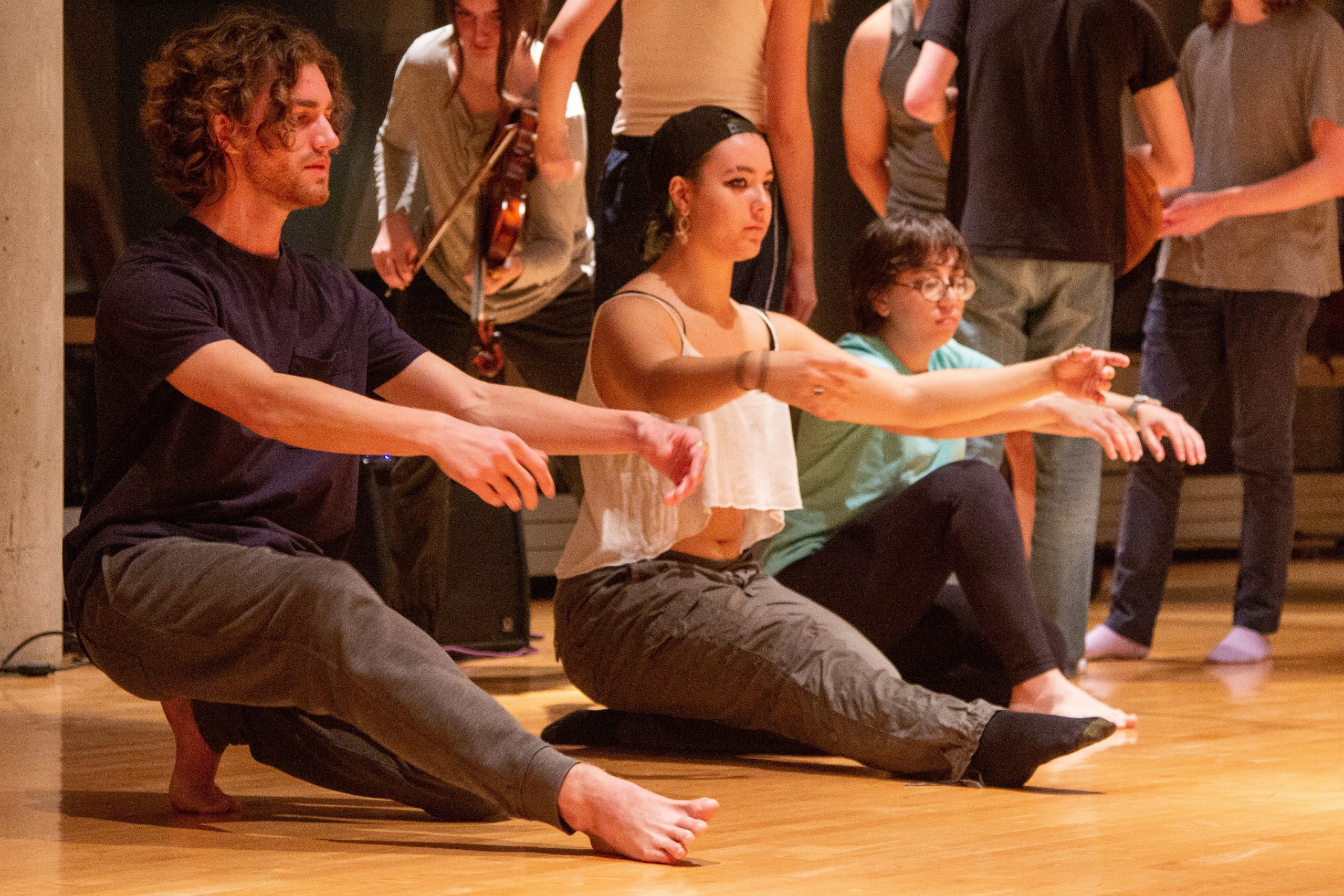Lawrence’s Dance Collective Ensemble (DCE) presented a collaborative performance with the Improvisation Group of Lawrence University (IGLU) on Oct. 24 in the Esch-Hurvis Room of the Warch Campus Center.
As the performers assembled, I noticed a surprising conglomeration of instruments: viola, cello, French horn, melodica, accordion and guitar, among others. Before the performance began, Prof. Paek, director of the DCE, instructed the performers to “listen to each other more than just aurally,” setting the tone for the evening and bringing to mind the communicative and expressive possibilities within improvised collaborative creation.
The performance began with instrumentalists and dancers intermixed and spread across the room. Because of the wide but shallow space, performers were close to the audience, allowing for a sense of personal connection between audience and performers.
During this first improvised piece, both dancers and instrumentalists moved intentionally through the space, shaping narratives with their movement. Performers created sound with their instruments and with body percussion, and some sounds were electronically generated or manipulated. The overall effect of the dance and music was eerie and made me imagine a dystopian wasteland.
After this piece, Prof. Paek welcomed the audience and explained the improvisatory nature of the performance, saying, “They don’t know what’s going to happen, we [herself and IGLU director Matt Turner] don’t know what’s going to happen — neither do you. Let’s have fun!”
The performance then took on a small-group format, in which five or six performers at a time would self-select to create a piece together. The first of these groups included a violinist, a violist and three dancers. As the instrumentalists danced while playing and the sounds of the dancing formed part of the piece, it became more difficult to discern a boundary between dance and music.
In one part of the improvisation, the violinist held their instrument while other performers passed around the bow and took turns using it to play the violin, creating a disjointed but playful series of musical fragments.
The next group included accordion and singing in a reassuring, almost lullaby-like style, with satisfying moments in which harmonies emerged spontaneously from a single pitch. The group incorporated variations of sitting and lying on the ground in different positions, interacting with each other and following each other’s leads. They also experimented with breath sounds as part of the music.
The third group featured a wider array of instruments, composed of a saxophone, cello, violin, guitar and two melodicas. These performers created a gently percussive piece, as the saxophone and melodica players pressed the keys of their instruments without blowing air into them, producing a blend of clicking sounds. The cellist drummed on the strings below the bridge of the instrument with their fingers, contributing subtly to the musical texture. As the piece progressed, the violinist introduced slow melodic ideas, and the other instruments joined in with crunchy harmonies, creating a mournful atmosphere overall.
The next group, consisting of violin, viola, French horn and two dancers, began close together, with some performers sitting and others standing, creating a pyramid-like formation. As their piece began, the string players moved around as a pair, while the dancers alternated between movements that were closer to the ground and ones that were more vertical, creating an up-and-down effect. Towards the end, the group melded into a revolving circle and produced shrieking sounds from the string instruments and vocalizations.

While some of the groups had complete freedom in what they created, others were given prompts, such as “give and take focus” or “maintain a constant pitch and move at your own tempo” or “create a series of seven-second improvisations, each with a beginning, middle and end” that guided their artistic output.
Another of these prompts was “you can only move if everybody’s moving; you have to be still if anybody’s still.” Two of the performers began sitting on the ground with their legs intertwined with each other. The group moved in bursts of motion and froze in sculptural positions, sometimes reaching out to each other, before finishing with everyone lying on the ground.
The last two groups each contained eight performers. In the first of these groups, one performer was instructed to lead two other performers, so that three of the performers all did the same actions, involving snapping, humming and arm movements, while the other five performers experimented with unconventional musical techniques, like tapping the bow against the back of a violin, to create the soundscape and ambience.
The final group began in a single-file line, making soft whistling and breathing sounds that emulated wind and the pattering of rain, appropriate for this time of year. They dispersed across the room, and several of the performers began intentionally coughing in turns, creating an unsettling, relevant chorus.
Several other performers gathered around the grand piano that was placed towards one end of the room. One performer played notes in the upper range of the piano, while another lay underneath the piano, dragging their hands across the underside, and a third performer drummed quietly on the sides and lid of the piano.
This joint performance with IGLU and DCE was unconventional and enjoyable to watch. Because of its spontaneous, improvised nature, the performers constantly took us in surprising directions, and the spirit of unrestrained experimentation with different sounds and movements as music and dance opened up a sense of broader possibility for what these art forms can be.


